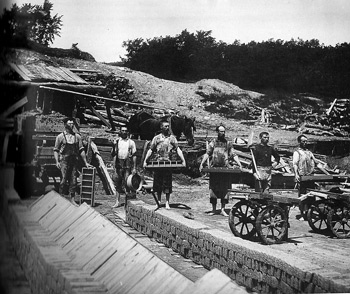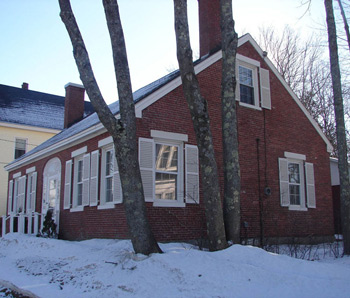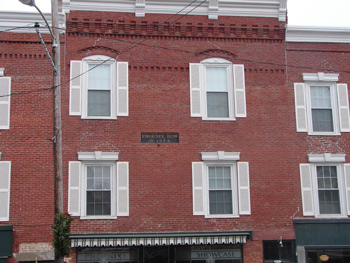Maine Bricks –
A Tradition Born of Necessity
by Tom Seymour

In 1886, Brewer, Maine, boasted of 11 brickyards. These collectively produced some 9.4 million bricks per year. A Hobbs mud machine upper left, mixed the mud for bricks with horse-power at a Newcastle brickyard. Photo courtesy Maine State Museum
Driving along Maine’s coast and through riverside communities in Maine’s interior, the traveler sees and often admires structures made of native Maine brick. These range in nature from government buildings to private residences. Maine, until not too long ago, was home to countless brick manufacturers, some large-scale commercial businesses and others, small-time cottage industries. The latter no doubt outnumbered the former by several magnitudes.
Farm Chores
Once, when so many Mainers lived on family farms, brick-making was only one of a multitude of seasonal chores. In this case, it was usually a cottage industry, meant to add some extra cash to the family’s coffers. Of course this depended upon the availability of clay. Without clay, brick-making was impossible.
Fortunately, clay deposits are common in much of Maine, particularly along the coast and also, near streams and rivers in inland towns. Clay pits, where the raw material for Maine bricks was quarried, are much in evidence today. It takes a bit of practice to recognize these for what they are, however. People who hike, hunt and fish are in a good position to note these places where old-timers mined their clay. Here’s what to look for.
First, bricks were usually fired (exposed to extreme heat in a one-use kiln) close to the source of clay. To do otherwise just added to the amount of labor needed to obtain the finished product. In the process of firing, cooling and stacking, a certain number of bricks would break and were consequently discarded. These linger today, tangible evidence of past brick-making efforts.
The presence of these old bricks and bits of bricks should alert the keen observer to begin the search for a clay pit. Most clay pits exhibit some kind of geometric design such as squares and rectangles. Often, these were cut into a streamside bank or in the case of seaside clay pits, in oceanside banks. And today, while usually covered with some kind of vegetation, the shape of these pits serves as an important clue to their true identity.

In the mid-19th century, many Maine cities and towns experienced devastating fires. In starting anew builders chose brick over wood. Many of these buildings, made of Maine brick, are standing today. Photo by Tom Seymour
The Process
To make bricks, clay was dug, cleaned of clinging debris, scraped fine and dried in the sun. After this, the clay was mixed with water and when this reached the desired consistency, the resulting slurry was shaped in wooden molds. After that, the “green” bricks were allowed to dry to a point where they could be stacked in arches, forming an ersatz “kiln.” Finally, hot fires were built inside the arches and kept going for a week or more.
The resulting products were usually red or orange-colored, a result of the clay being fired in the kilns. Thus, grayish-white clay was turned in to reddish-colored bricks.
Since the manual labor necessary to brick production was immense, it was only natural that people eventually employed mechanical devices. One of these was known as the “Hobbs Mud Machine” and it made life considerably easier, particularly for those who produced bricks on a large scale.
The Hobbs Mud Machine used horsepower to turn a series of blades, which mixed clay and water. The mixture was then emptied into a press box that accepted six bricks at a time, far superior to the single-brick method used by small-time brick makers.
One Mainer, Ambrose Strout of Belfast, was an inveterate inventor. Strout patented a special press for compacting hay bales. This machine saw use throughout the United States and the Canadian Provinces. Strout also was a brick maker (one of many in old-time Belfast) and designed and manufactured the mechanical brick-making devices used at his own brick kiln.
Building Bricks
Maine-made bricks differ slightly from bricks made in other regions due to the physical makeup of the native clay. Maine clay contains a variety of minerals thanks to the mixing and grinding of glaciers. Therefore, bricks of Maine clay are not suitable for industrial, high-temperature uses. Some people call Maine bricks, “soft” bricks.
However, this does not imply that Maine bricks were not perfectly satisfactory for standard construction uses. Indeed, the huge number of brickyards both large and small and the amount of bricks produced each year attest to the desirability of Maine-made bricks for building uses.
For instance, in 1886, Brewer, Maine, boasted 11 brickyards. These collectively produced some 9.4 million bricks per year. A lively shipping trade existed, where a large portion, about half of each year’s production, was shipped to states south of Maine. Also, bricks served as ballast for ships carrying other cargo, such as lumber.
Looking back at the history of Maine houses and commercial buildings, we see that early on, pretty much all structures were made of wood. Lumber was, after all, king, and Maine was the principal supplier of lumber for in-state and out-of-state uses.
But in the mid-19th century, many Maine cities and towns experienced devastating fires. In starting anew, as it were, builders chose brick over wood. Many of these buildings, made of Maine brick, are standing today, a testimony to the once-thriving brick industry in the Pine Tree State. Large, destructive fires were common elsewhere and cities such as Boston, New York City and Baltimore all chose Maine brick for their rebuilding efforts. Maine brick also supplied the needs of European builders to some extent.

Phoenix Row, High St., Belfast. In the mid-19th century, many Maine cities and towns experienced devastating fires. In starting anew builders chose brick over wood. Many of these buildings, made of Maine brick, are standing today. Photo by Tom Seymour
Belfast Example
While Brewer gathered the most laurels for its brick, smaller cities also listed brickyards in their inventory of local industries. Belfast can easily serve as an example of this. Of course similar situations existed up and down the Maine coast.
The History of Belfast, Volume 1, by Joseph Williamson, supplies us with an early reference to the use of bricks in building: “Three brick stores, the first here, were built in 1821, on the site of the present Granite Block on Maine Street, by Lord and Merrill.”
The above-mentioned volume also lists two men as “brick inspectors” for the year 1800. This was an official town office and according to Williamson, was revived in 1800, having been out of use for many years prior to that date.
Also, a cape-style house on Maine Street is built of brick and said by local historians, to date back prior to 1820. This house remains intact, the only major change over the years was to remove two of the four original chimneys.
Also, the “Brick Block” on Main Street, was built in 1823. These, as was so often the custom, served several purposes, with the ground level being used as stores and the upper stories (in this case, the buildings were three stories) outfitted as living quarters.
One of the most impressive of Belfast’s brick buildings was the “City Block” on the corner of Main and High Streets. Built in 1850, this building stands today and hosts several businesses.
But now the old Belfast brickyards have long since vanished, reduced to brick rubble strewn along the shore. But the bricks produced in them remain, testimony to the industrious nature of old-time Mainers.
Maine Versus Imported
Some bricks used in Maine were imported from England. These, being better able to withstand weathering, were supposedly used as facings on structures made of native brick. This practice, however, was perhaps not as widespread as some may believe.
As an example of this, anyone interested can easily find some native bricks by walking the seashore or rivershore of any large Maine town or city. Then, with an original brick in hand, compare it to those used on the outside of any historic brick building. In many cases, the two are identical in every way, including color and also, imperfections.
While not of any value as collector’s items, these old Maine bricks are a tangible link to a time when Maine relied primarily upon its own resources, both natural and human. Pick one up, hold it and marvel.
